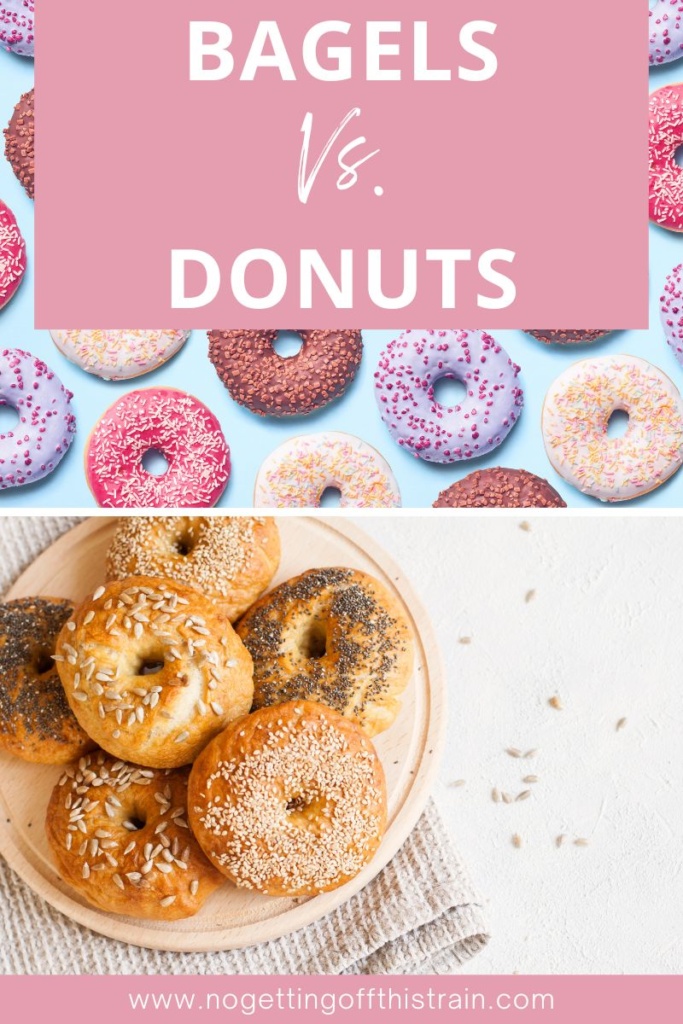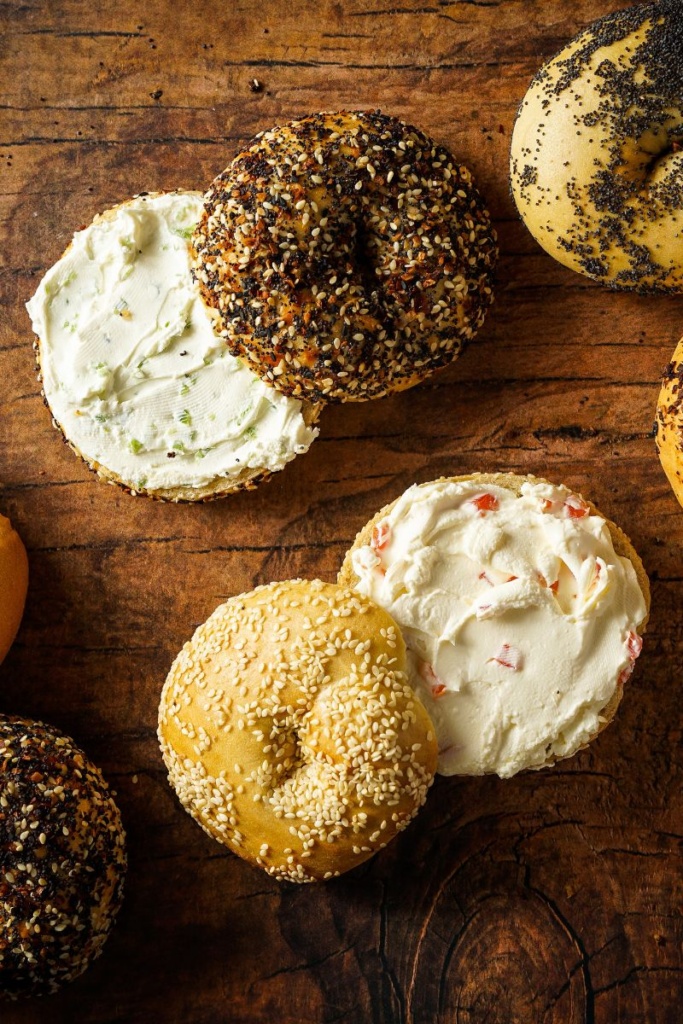Bagels and donuts are two popular breakfast foods. But which is the healthier choice? Here’s a detailed breakdown of the two!
Breakfast is my FAVORITE meal of the day. And honestly, it’s the most important meal of the day for me.
I’m always starving in the mornings, so a good breakfast helps fuel me and actually helps me think better. And with a young daughter at home, I need a good head on my shoulders!
Two popular items, among other breakfast options, are bagels and donuts. If you work outside the home, you may find a box of either popular choice sitting in the break room for you to enjoy.

And if you’re becoming more health-conscious, you may wonder which is the healthier choice. It might be obvious- but maybe not!
The short answer is, both bagels and donuts can be healthy options depending on your goals for the day. Whether it’s wanting to stay full longer or just wanting a nice treat, there are good reasons to choose either!
If you want a further explanation, though, I’m going into more detail below. I list the nutritional differences for both donuts and bagels and go in-depth on how they can affect your body after you eat them.
Disclaimer: I’m not a medical doctor and this isn’t medical advice. I’m just a Nutrition Coach who has done a bit of research!

A quick run-down of the differences
Yes, they’re both ring-shaped bread and have holes. But they also have obvious differences.
Bagel
- Chewy texture
- Usually boiled and baked
- Can be savory or sweet: Plain, asiago cheese, poppy seeds, cinnamon raisin, blueberry
- Usually eaten with a smear of cream cheese
Donut
- Much softer texture- yeast donuts have a crispier outside
- Can be fried or baked
- Are almost always sweet, with various flavors
- Can be topped with icing and sprinkles
Nutritional values for bagels
Here’s the info for an average plain bagel, taken from the Thomas brand website:
- Calories: 270
- Total fat: 1.5g
- Sodium: 450mg
- Carbohydrates: 53g
- Fiber: 2g
- Added sugars: 5g
- Protein: 10g

Nutrition info for donuts
For this comparison, I chose a simple glazed donut from the Dunkin Donuts website:
- Calories: 240
- Total fat: 11g
- Sodium: 270g
- Carbohydrates: 33g
- Fiber: 1g
- Added sugars: 12g
- Protein: 4g
I know it’s a lot of numbers, but below I’m going to break down what it all means for you.
How each one affects your body
The info I’m giving is based on a standard 2,000-calorie diet. Everyone’s needs will vary, but just use this as a basic starting point.

Bagels
The bagel above has 270 calories. Eaten by itself, that may not be enough calories for a full breakfast.
And fat is filling. With only 1.5 grams of fat, you may not stay full very long after eating.
The sodium content of bagels is pretty high. That’s not normally a problem in a typical healthy person. But if you need to watch your sodium intake, just keep this in mind.
This bagel also has 53 grams of carbohydrates. Carbs give you energy, and bagels have a TON of carbs. Almost as much as 4 slices of bread.
The problem here is that with only 2 grams of fiber, and only a little fat, this bagel will give you a QUICK energy boost but may leave you with a “blood sugar crash” soon after.
One great thing about the bagel is the 10 grams of protein. Protein also helps with satiety, so that adds a nice boost of protein to your meal.
And this bagel also has less sugar than a donut. The sweeter bagels, like a blueberry bagel or cinnamon bagel, may have more.

Donuts
That regular glazed donut has 240 calories, which is fewer calories than the bagel. Keep in mind that these two are about the same portion size, too.
It also has a higher fat content at 11 grams of total fat, some of which is saturated fat. And some donuts may have a little bit of trans fat, which can raise the “bad” cholesterol and lower the “good” cholesterol.
In terms of carbohydrates, this one only has 33 grams of carbs, which is less than the bagel. But it also has more added grams of sugar, which could give you a quick burst of energy but then leave you dragging an hour later.
And lastly, 4 grams of protein isn’t quite enough for a full meal. If eaten by itself, you’ll probably be hungry again soon afterward.

So which one is the healthier option?
So this depends on what your goals are.
If you want a more filling breakfast food, a bagel is a good choice because of the extra protein.
If you want a nice sweet treat to enjoy in the morning, choose the donut.
And this ALL depends on what type of doughnut or bagel you choose, too. The huge cream-filled donuts will have a higher calorie count than a simple glazed doughnut or even a cake donut or plain donuts. And a large single bagel from Panera Bread will have more calories than the kind from grocery stores.
Can you make these part of a healthy lifestyle?
I’m of the opinion that you should ADD things to your diet, not remove them. Adding additional things can boost nutrition and keep you full longer.
This means you can still enjoy donuts and not deprive yourself. Because telling yourself you can never have a donut again guarantees that you’ll go crazy the next time you’re offered a box of donuts.
Here are some ways you can add extra nutrition to your meal and still enjoy these foods!
- Add some cream cheese, peanut butter, or avocado to your bagel. The right toppings will add some healthy fats and keep you full much longer.
- Opt for a whole wheat bagel instead. Whole grains have much more dietary fiber and a bit more protein, which will boost fullness. A multigrain bagel isn’t quite the same, as it isn’t normally made with whole wheat.
- Eat your bagel as a sandwich! Adding foods like deli meat and cheese help boost the protein, and are easy to meal prep.
- Enjoy your donut with a side of protein. This can be scrambled eggs, Greek yogurt, cottage cheese, or sausage. The protein can help counteract a lot of the “sugar rush” so you won’t be craving more later.
Final thoughts
In the end, neither one is a much better choice than the other. You can still enjoy both breakfast items on a regular basis. But understanding how these foods affect your body can help you make better decisions in the moment!

Jaime is a Nutrition Coach through the ISSA and professional writer. She has 4 years experience coaching and 9 years experience in writing. She enjoys cooking easy meals, running, and learning more about food.
Jaime specializes in helping women with ADHD learn to meal plan and cook healthier meals without getting overwhelmed.
